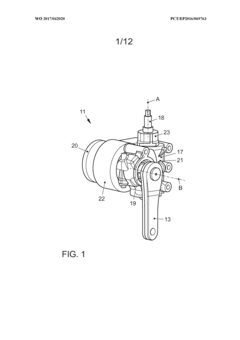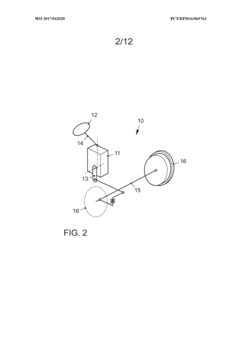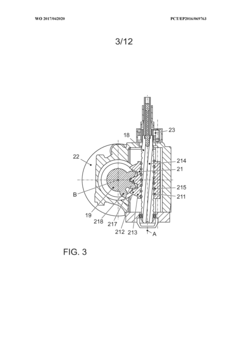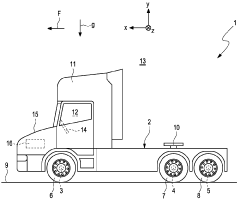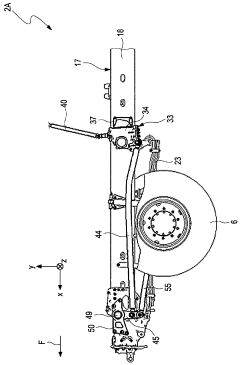Steering Wheel Innovations in Commercial Vehicle Design
JUL 18, 20259 MIN READ
Generate Your Research Report Instantly with AI Agent
Patsnap Eureka helps you evaluate technical feasibility & market potential.
Steering Tech Evolution
The evolution of steering technology in commercial vehicle design has been marked by significant milestones and innovations over the past century. Initially, steering systems in commercial vehicles were purely mechanical, relying on direct linkages between the steering wheel and the wheels. This design, while functional, required considerable physical effort from drivers, especially in larger vehicles.
The introduction of hydraulic power steering in the mid-20th century revolutionized commercial vehicle operation. This technology utilized hydraulic pressure to assist in turning the wheels, significantly reducing the physical effort required by drivers. This innovation not only improved driver comfort but also enhanced safety by allowing for more precise control of the vehicle.
As electronic systems became more prevalent in vehicle design, the next major advancement came in the form of electrohydraulic power steering. This hybrid system combined the benefits of hydraulic power with electronic control, allowing for more adaptive steering assistance based on vehicle speed and other factors. This technology paved the way for more sophisticated steering systems in commercial vehicles.
The late 20th and early 21st centuries saw the emergence of fully electric power steering (EPS) systems. EPS eliminated the need for hydraulic components, resulting in a more compact, energy-efficient, and environmentally friendly steering system. This technology also enabled more advanced features such as variable steering ratios and integration with driver assistance systems.
Recent years have witnessed the development of steer-by-wire technology, which completely removes the mechanical connection between the steering wheel and the wheels. This innovation allows for greater flexibility in vehicle design and enables advanced features such as autonomous driving capabilities. While still in its early stages for commercial vehicles, steer-by-wire technology represents a significant leap forward in steering system design.
The latest frontier in steering technology for commercial vehicles is the integration of artificial intelligence and machine learning. These technologies are being used to develop predictive steering systems that can anticipate driver intentions and road conditions, further enhancing safety and efficiency. Additionally, the advent of connected vehicle technology is enabling steering systems to respond to real-time traffic and road information, potentially revolutionizing fleet management and logistics operations.
As we look to the future, the evolution of steering technology in commercial vehicles is likely to continue its trajectory towards more intelligent, efficient, and integrated systems. The ongoing development of autonomous vehicles will undoubtedly drive further innovations in steering technology, potentially leading to entirely new paradigms in vehicle control and operation.
The introduction of hydraulic power steering in the mid-20th century revolutionized commercial vehicle operation. This technology utilized hydraulic pressure to assist in turning the wheels, significantly reducing the physical effort required by drivers. This innovation not only improved driver comfort but also enhanced safety by allowing for more precise control of the vehicle.
As electronic systems became more prevalent in vehicle design, the next major advancement came in the form of electrohydraulic power steering. This hybrid system combined the benefits of hydraulic power with electronic control, allowing for more adaptive steering assistance based on vehicle speed and other factors. This technology paved the way for more sophisticated steering systems in commercial vehicles.
The late 20th and early 21st centuries saw the emergence of fully electric power steering (EPS) systems. EPS eliminated the need for hydraulic components, resulting in a more compact, energy-efficient, and environmentally friendly steering system. This technology also enabled more advanced features such as variable steering ratios and integration with driver assistance systems.
Recent years have witnessed the development of steer-by-wire technology, which completely removes the mechanical connection between the steering wheel and the wheels. This innovation allows for greater flexibility in vehicle design and enables advanced features such as autonomous driving capabilities. While still in its early stages for commercial vehicles, steer-by-wire technology represents a significant leap forward in steering system design.
The latest frontier in steering technology for commercial vehicles is the integration of artificial intelligence and machine learning. These technologies are being used to develop predictive steering systems that can anticipate driver intentions and road conditions, further enhancing safety and efficiency. Additionally, the advent of connected vehicle technology is enabling steering systems to respond to real-time traffic and road information, potentially revolutionizing fleet management and logistics operations.
As we look to the future, the evolution of steering technology in commercial vehicles is likely to continue its trajectory towards more intelligent, efficient, and integrated systems. The ongoing development of autonomous vehicles will undoubtedly drive further innovations in steering technology, potentially leading to entirely new paradigms in vehicle control and operation.
Market Demand Analysis
The market demand for steering wheel innovations in commercial vehicle design has been steadily increasing in recent years, driven by several key factors. Safety considerations remain paramount, with fleet operators and regulators pushing for advanced driver assistance systems (ADAS) integrated into steering wheels. These systems aim to reduce accidents caused by driver fatigue, distraction, or human error, which are significant concerns in the commercial vehicle sector.
Ergonomics and driver comfort have also become crucial aspects of market demand. As commercial drivers spend long hours behind the wheel, there is a growing emphasis on steering wheel designs that reduce physical strain and improve overall driving experience. This includes adjustable steering columns, ergonomic grip designs, and materials that enhance comfort during extended use.
The rise of electric and autonomous commercial vehicles is reshaping market expectations for steering wheel design. There is an increasing demand for steering systems that can seamlessly transition between manual and autonomous driving modes, requiring innovative interfaces and control mechanisms integrated into the steering wheel.
Connectivity and data integration are becoming essential features in commercial vehicle steering wheels. Fleet managers and logistics companies are seeking solutions that provide real-time data on driver behavior, vehicle performance, and route optimization directly through the steering wheel interface. This trend is driving demand for steering wheels equipped with advanced displays and touch-sensitive controls.
Customization and modularity are emerging as significant market demands. Different commercial vehicle applications, from long-haul trucking to urban delivery, require tailored steering solutions. Manufacturers are increasingly looking for steering wheel designs that can be easily adapted or modified to suit specific vehicle types and operational requirements.
Sustainability considerations are also influencing market demand. There is a growing interest in steering wheel materials and manufacturing processes that reduce environmental impact, aligning with broader sustainability goals in the commercial vehicle industry.
The market size for steering wheel innovations in commercial vehicles is substantial, with the global commercial vehicle market projected to reach significant growth in the coming years. This growth, coupled with the increasing integration of advanced technologies in vehicles, suggests a robust and expanding market for steering wheel innovations.
Ergonomics and driver comfort have also become crucial aspects of market demand. As commercial drivers spend long hours behind the wheel, there is a growing emphasis on steering wheel designs that reduce physical strain and improve overall driving experience. This includes adjustable steering columns, ergonomic grip designs, and materials that enhance comfort during extended use.
The rise of electric and autonomous commercial vehicles is reshaping market expectations for steering wheel design. There is an increasing demand for steering systems that can seamlessly transition between manual and autonomous driving modes, requiring innovative interfaces and control mechanisms integrated into the steering wheel.
Connectivity and data integration are becoming essential features in commercial vehicle steering wheels. Fleet managers and logistics companies are seeking solutions that provide real-time data on driver behavior, vehicle performance, and route optimization directly through the steering wheel interface. This trend is driving demand for steering wheels equipped with advanced displays and touch-sensitive controls.
Customization and modularity are emerging as significant market demands. Different commercial vehicle applications, from long-haul trucking to urban delivery, require tailored steering solutions. Manufacturers are increasingly looking for steering wheel designs that can be easily adapted or modified to suit specific vehicle types and operational requirements.
Sustainability considerations are also influencing market demand. There is a growing interest in steering wheel materials and manufacturing processes that reduce environmental impact, aligning with broader sustainability goals in the commercial vehicle industry.
The market size for steering wheel innovations in commercial vehicles is substantial, with the global commercial vehicle market projected to reach significant growth in the coming years. This growth, coupled with the increasing integration of advanced technologies in vehicles, suggests a robust and expanding market for steering wheel innovations.
Current Challenges
The steering wheel, a critical interface between driver and vehicle, faces several challenges in the context of commercial vehicle design. These challenges stem from the evolving nature of transportation, technological advancements, and changing regulatory landscapes.
One of the primary challenges is the integration of advanced driver assistance systems (ADAS) into steering wheel design. As commercial vehicles increasingly incorporate semi-autonomous features, steering wheels must accommodate a range of sensors and controls without compromising ergonomics or safety. This integration often leads to increased complexity and cost in manufacturing processes.
Driver comfort and fatigue reduction present another significant challenge. Long-haul commercial drivers spend extended periods behind the wheel, necessitating designs that minimize physical strain and maintain alertness. Achieving the right balance between comfort and control responsiveness remains a persistent issue for designers and engineers.
The advent of electric and hybrid commercial vehicles introduces new challenges in steering wheel design. These vehicles often require different steering mechanisms, such as steer-by-wire systems, which can alter the feel and feedback traditionally associated with mechanical linkages. Adapting steering wheels to provide accurate haptic feedback in these new systems is crucial for driver confidence and safety.
Regulatory compliance adds another layer of complexity to steering wheel innovations. Safety standards for commercial vehicles are becoming increasingly stringent, requiring steering wheels to incorporate airbags, impact-absorbing materials, and other safety features without compromising functionality or aesthetics.
Customization and adaptability pose additional challenges. Commercial vehicle fleets often serve diverse purposes, from long-haul transportation to urban delivery. Designing steering wheels that can be easily customized or adapted to different vehicle types and driver preferences while maintaining standardization for manufacturing efficiency is a delicate balance to strike.
The push towards more sustainable and environmentally friendly materials in vehicle manufacturing extends to steering wheels. Developing eco-friendly materials that meet the durability and performance requirements of commercial vehicle steering wheels, while also being cost-effective, presents ongoing challenges for manufacturers.
Lastly, the potential for future autonomous commercial vehicles raises questions about the role and design of steering wheels. As vehicles become more automated, steering wheel designs must evolve to accommodate occasional manual control while potentially serving new functions in a predominantly autonomous driving environment. This transition phase presents complex design and safety challenges that current innovations must anticipate and address.
One of the primary challenges is the integration of advanced driver assistance systems (ADAS) into steering wheel design. As commercial vehicles increasingly incorporate semi-autonomous features, steering wheels must accommodate a range of sensors and controls without compromising ergonomics or safety. This integration often leads to increased complexity and cost in manufacturing processes.
Driver comfort and fatigue reduction present another significant challenge. Long-haul commercial drivers spend extended periods behind the wheel, necessitating designs that minimize physical strain and maintain alertness. Achieving the right balance between comfort and control responsiveness remains a persistent issue for designers and engineers.
The advent of electric and hybrid commercial vehicles introduces new challenges in steering wheel design. These vehicles often require different steering mechanisms, such as steer-by-wire systems, which can alter the feel and feedback traditionally associated with mechanical linkages. Adapting steering wheels to provide accurate haptic feedback in these new systems is crucial for driver confidence and safety.
Regulatory compliance adds another layer of complexity to steering wheel innovations. Safety standards for commercial vehicles are becoming increasingly stringent, requiring steering wheels to incorporate airbags, impact-absorbing materials, and other safety features without compromising functionality or aesthetics.
Customization and adaptability pose additional challenges. Commercial vehicle fleets often serve diverse purposes, from long-haul transportation to urban delivery. Designing steering wheels that can be easily customized or adapted to different vehicle types and driver preferences while maintaining standardization for manufacturing efficiency is a delicate balance to strike.
The push towards more sustainable and environmentally friendly materials in vehicle manufacturing extends to steering wheels. Developing eco-friendly materials that meet the durability and performance requirements of commercial vehicle steering wheels, while also being cost-effective, presents ongoing challenges for manufacturers.
Lastly, the potential for future autonomous commercial vehicles raises questions about the role and design of steering wheels. As vehicles become more automated, steering wheel designs must evolve to accommodate occasional manual control while potentially serving new functions in a predominantly autonomous driving environment. This transition phase presents complex design and safety challenges that current innovations must anticipate and address.
Existing Solutions
01 Steering wheel design and ergonomics
Innovations in steering wheel design focus on improving ergonomics and driver comfort. This includes optimizing the shape, size, and grip of the steering wheel to reduce fatigue during long drives and enhance control. Advanced materials and manufacturing techniques are employed to create steering wheels that are both functional and aesthetically pleasing.- Steering wheel design and ergonomics: Innovations in steering wheel design focus on improving ergonomics and driver comfort. This includes optimizing the shape, size, and grip of the steering wheel to reduce fatigue during long drives and enhance control. Advanced designs may incorporate adjustable features to accommodate different driver preferences and body types.
- Integration of controls and displays: Modern steering wheels often integrate various controls and displays to enhance driver convenience and safety. This can include buttons for audio and cruise control, touch-sensitive surfaces, and small screens for displaying vehicle information. The goal is to provide easy access to essential functions without requiring the driver to take their hands off the wheel.
- Advanced safety features: Steering wheels are being equipped with advanced safety features such as airbags and sensors. These innovations aim to protect the driver in case of collisions and can also detect driver fatigue or distraction. Some designs incorporate heating elements for improved comfort in cold weather conditions.
- Materials and manufacturing techniques: Advancements in materials and manufacturing techniques are improving the durability, weight, and feel of steering wheels. This includes the use of lightweight alloys, high-quality synthetic materials, and precision manufacturing processes to enhance the overall quality and performance of the steering wheel.
- Steering mechanisms and power assistance: Innovations in steering mechanisms and power assistance systems are enhancing the responsiveness and ease of steering. This includes improvements in electric power steering, adaptive steering ratios, and advanced algorithms for better feedback and control. These technologies aim to provide a more precise and effortless steering experience across various driving conditions.
02 Integration of controls and displays
Modern steering wheels incorporate various controls and displays to enhance driver convenience and safety. These may include buttons for audio control, cruise control, and phone operations, as well as small screens or heads-up displays for providing important vehicle information without requiring the driver to look away from the road.Expand Specific Solutions03 Steering wheel heating and cooling systems
To improve comfort in various weather conditions, steering wheels are being equipped with heating and cooling systems. These systems can quickly adjust the temperature of the steering wheel surface, providing a more pleasant driving experience in extreme hot or cold environments.Expand Specific Solutions04 Advanced safety features in steering wheels
Steering wheels are being designed with advanced safety features to protect drivers in the event of a collision. This includes the integration of airbags directly into the steering wheel, as well as energy-absorbing materials and structures to minimize injury during impacts.Expand Specific Solutions05 Adjustable and customizable steering wheels
Innovations in steering wheel technology allow for greater adjustability and customization. This includes steering wheels that can change shape or size to accommodate different drivers, as well as those that can be easily removed or replaced for racing or security purposes. Some designs also incorporate memory functions to recall preferred settings for multiple drivers.Expand Specific Solutions
Key Industry Players
The steering wheel innovation landscape in commercial vehicle design is currently in a mature yet evolving phase, with a market size estimated in the billions due to the global commercial vehicle sector's growth. Technological maturity varies across different aspects of steering systems, from traditional mechanical designs to advanced electronic and autonomous solutions. Key players like ZF Friedrichshafen AG, Autoliv Development AB, and Knorr-Bremse Systeme für Nutzfahrzeuge GmbH are driving innovation in this space. Companies such as Volvo Lastvagnar AB, MAN Truck & Bus SE, and Dongfeng Commercial Vehicles Co., Ltd. are also contributing significantly to steering wheel advancements in commercial vehicles, focusing on ergonomics, safety features, and integration with advanced driver assistance systems.
GM Global Technology Operations LLC
Technical Solution: GM has developed an innovative steering wheel system for commercial vehicles that incorporates advanced haptic feedback and adaptive controls. The system uses electromagnetic actuators to provide precise tactile sensations to the driver, enhancing situational awareness and reducing driver fatigue[1]. Additionally, the steering wheel features integrated touchscreen displays for easy access to vehicle information and controls. GM's solution also includes a steer-by-wire system that eliminates the mechanical connection between the steering wheel and the wheels, allowing for more flexible cabin design and improved safety in collisions[3].
Strengths: Enhanced driver feedback, improved ergonomics, and increased safety. Weaknesses: Higher cost compared to traditional systems and potential reliability concerns with complex electronics.
ZF Friedrichshafen AG
Technical Solution: ZF has introduced a revolutionary steering wheel concept for commercial vehicles called "Hands-On Detection" (HOD). This system uses capacitive sensing technology embedded in the steering wheel to detect the driver's hand position and grip strength[2]. The HOD system integrates with advanced driver assistance systems (ADAS) to ensure proper driver engagement and improve safety. ZF has also developed a retractable steering wheel system for autonomous driving scenarios, which can fold away when not in use, maximizing cabin space and flexibility[4]. The company's steering innovations include lightweight materials and modular designs to accommodate various vehicle types and sizes.
Strengths: Advanced driver monitoring capabilities, adaptability for autonomous driving, and improved cabin ergonomics. Weaknesses: Complexity of integration with existing vehicle systems and potential high costs for implementation.
Core Innovations
Utility vehicle steering system
PatentWO2017042020A1
Innovation
- A commercial vehicle steering system utilizing an electric motor for exclusive electrical power assistance, featuring a skewed input and output shaft with a high-ratio coaxial gear mechanism, eliminating the need for hydraulic components and achieving compact design with high torque output.
Utility vehicle
PatentWO2023193983A1
Innovation
- A commercial vehicle design with a steering system where the steering gear is positioned between the front and rear axles, utilizing a deflection lever and coupling rods to steer the front axle wheels, allowing for a more powerful engine installation and increased application range by enabling a hood that protrudes beyond the front axle.
Safety Regulations
Safety regulations play a crucial role in shaping the design and implementation of steering wheel innovations in commercial vehicles. These regulations are established to ensure the safety of drivers, passengers, and other road users, while also promoting the overall efficiency and reliability of commercial vehicle operations.
In the United States, the National Highway Traffic Safety Administration (NHTSA) is responsible for setting and enforcing safety standards for motor vehicles, including commercial vehicles. The Federal Motor Vehicle Safety Standards (FMVSS) provide specific requirements for steering systems, including steering wheel design and performance. These standards address factors such as steering control, steering column displacement, and impact protection.
The European Union has its own set of regulations, governed by the United Nations Economic Commission for Europe (UNECE). Regulation No. 79 specifically addresses steering equipment for vehicles, including commercial vehicles. This regulation outlines requirements for steering effort, turning circle, and the behavior of the steering system in case of failure.
One of the key safety considerations in steering wheel design is the integration of airbag systems. Regulations mandate the inclusion of driver airbags in commercial vehicles, which necessitates careful design of the steering wheel to accommodate these safety devices while maintaining optimal ergonomics and functionality.
As autonomous and semi-autonomous technologies advance, safety regulations are evolving to address new challenges. For instance, the development of steer-by-wire systems, which replace traditional mechanical linkages with electronic controls, has prompted regulatory bodies to establish new standards for system reliability, redundancy, and fail-safe mechanisms.
The increasing focus on driver fatigue and distraction has also influenced steering wheel regulations. Many jurisdictions now require or encourage the implementation of lane departure warning systems and stability control features, which often interface with the steering system. These technologies must be seamlessly integrated into the steering wheel design while complying with existing safety standards.
Furthermore, regulations are beginning to address the concept of adaptive steering systems, which can adjust steering ratios and feedback based on vehicle speed and driving conditions. These systems must demonstrate consistent performance and safety across a wide range of operating scenarios to meet regulatory approval.
As commercial vehicle designs continue to evolve, safety regulations will likely expand to cover emerging technologies such as haptic feedback systems and gesture-based controls integrated into steering wheels. Regulatory bodies will need to balance the potential safety benefits of these innovations with the need to ensure reliable and predictable vehicle control under all circumstances.
In the United States, the National Highway Traffic Safety Administration (NHTSA) is responsible for setting and enforcing safety standards for motor vehicles, including commercial vehicles. The Federal Motor Vehicle Safety Standards (FMVSS) provide specific requirements for steering systems, including steering wheel design and performance. These standards address factors such as steering control, steering column displacement, and impact protection.
The European Union has its own set of regulations, governed by the United Nations Economic Commission for Europe (UNECE). Regulation No. 79 specifically addresses steering equipment for vehicles, including commercial vehicles. This regulation outlines requirements for steering effort, turning circle, and the behavior of the steering system in case of failure.
One of the key safety considerations in steering wheel design is the integration of airbag systems. Regulations mandate the inclusion of driver airbags in commercial vehicles, which necessitates careful design of the steering wheel to accommodate these safety devices while maintaining optimal ergonomics and functionality.
As autonomous and semi-autonomous technologies advance, safety regulations are evolving to address new challenges. For instance, the development of steer-by-wire systems, which replace traditional mechanical linkages with electronic controls, has prompted regulatory bodies to establish new standards for system reliability, redundancy, and fail-safe mechanisms.
The increasing focus on driver fatigue and distraction has also influenced steering wheel regulations. Many jurisdictions now require or encourage the implementation of lane departure warning systems and stability control features, which often interface with the steering system. These technologies must be seamlessly integrated into the steering wheel design while complying with existing safety standards.
Furthermore, regulations are beginning to address the concept of adaptive steering systems, which can adjust steering ratios and feedback based on vehicle speed and driving conditions. These systems must demonstrate consistent performance and safety across a wide range of operating scenarios to meet regulatory approval.
As commercial vehicle designs continue to evolve, safety regulations will likely expand to cover emerging technologies such as haptic feedback systems and gesture-based controls integrated into steering wheels. Regulatory bodies will need to balance the potential safety benefits of these innovations with the need to ensure reliable and predictable vehicle control under all circumstances.
Ergonomic Considerations
Ergonomic considerations play a crucial role in steering wheel innovations for commercial vehicles, as they directly impact driver comfort, safety, and overall performance. The design of steering wheels must account for the extended periods that commercial vehicle operators spend behind the wheel, often in challenging environments and conditions.
One key aspect of ergonomic design is the steering wheel's shape and size. Modern commercial vehicle steering wheels are increasingly adopting a flattened bottom section, which provides more leg room and easier entry and exit for drivers. This design also allows for better positioning of instrument clusters and controls, enhancing visibility and accessibility.
The grip of the steering wheel is another critical ergonomic factor. Manufacturers are experimenting with various materials and textures to provide optimal grip in different conditions, such as when wearing gloves or during long hauls. Some innovative designs incorporate heating elements in the grip to improve comfort in cold climates and reduce driver fatigue.
Adjustability is becoming increasingly important in steering wheel design. Many new commercial vehicles feature steering columns with multiple adjustment points, allowing drivers to customize their position for maximum comfort and control. This includes tilt and telescopic adjustments, as well as memory settings for quick changes between different drivers.
The integration of controls into the steering wheel itself is an evolving area of ergonomic design. By placing frequently used functions such as cruise control, audio settings, and communication systems directly on the steering wheel, designers can reduce driver distraction and improve overall safety. However, care must be taken to ensure that these controls are intuitive and do not overcomplicate the steering wheel's primary function.
Vibration reduction is another crucial ergonomic consideration. Commercial vehicles are subject to significant vibrations, which can lead to driver fatigue and potential health issues over time. Advanced damping systems and materials are being incorporated into steering wheel design to minimize these vibrations and provide a smoother driving experience.
Weight reduction in steering wheel design is also gaining attention. Lighter steering wheels can reduce driver fatigue, especially in vehicles without power steering. However, this must be balanced with the need for durability and the integration of various controls and technologies.
As autonomous and semi-autonomous driving technologies advance, steering wheel ergonomics are evolving to accommodate new functionalities. Designs that can retract or change shape to facilitate different driving modes are being explored, presenting new challenges and opportunities in ergonomic design.
One key aspect of ergonomic design is the steering wheel's shape and size. Modern commercial vehicle steering wheels are increasingly adopting a flattened bottom section, which provides more leg room and easier entry and exit for drivers. This design also allows for better positioning of instrument clusters and controls, enhancing visibility and accessibility.
The grip of the steering wheel is another critical ergonomic factor. Manufacturers are experimenting with various materials and textures to provide optimal grip in different conditions, such as when wearing gloves or during long hauls. Some innovative designs incorporate heating elements in the grip to improve comfort in cold climates and reduce driver fatigue.
Adjustability is becoming increasingly important in steering wheel design. Many new commercial vehicles feature steering columns with multiple adjustment points, allowing drivers to customize their position for maximum comfort and control. This includes tilt and telescopic adjustments, as well as memory settings for quick changes between different drivers.
The integration of controls into the steering wheel itself is an evolving area of ergonomic design. By placing frequently used functions such as cruise control, audio settings, and communication systems directly on the steering wheel, designers can reduce driver distraction and improve overall safety. However, care must be taken to ensure that these controls are intuitive and do not overcomplicate the steering wheel's primary function.
Vibration reduction is another crucial ergonomic consideration. Commercial vehicles are subject to significant vibrations, which can lead to driver fatigue and potential health issues over time. Advanced damping systems and materials are being incorporated into steering wheel design to minimize these vibrations and provide a smoother driving experience.
Weight reduction in steering wheel design is also gaining attention. Lighter steering wheels can reduce driver fatigue, especially in vehicles without power steering. However, this must be balanced with the need for durability and the integration of various controls and technologies.
As autonomous and semi-autonomous driving technologies advance, steering wheel ergonomics are evolving to accommodate new functionalities. Designs that can retract or change shape to facilitate different driving modes are being explored, presenting new challenges and opportunities in ergonomic design.
Unlock deeper insights with Patsnap Eureka Quick Research — get a full tech report to explore trends and direct your research. Try now!
Generate Your Research Report Instantly with AI Agent
Supercharge your innovation with Patsnap Eureka AI Agent Platform!
